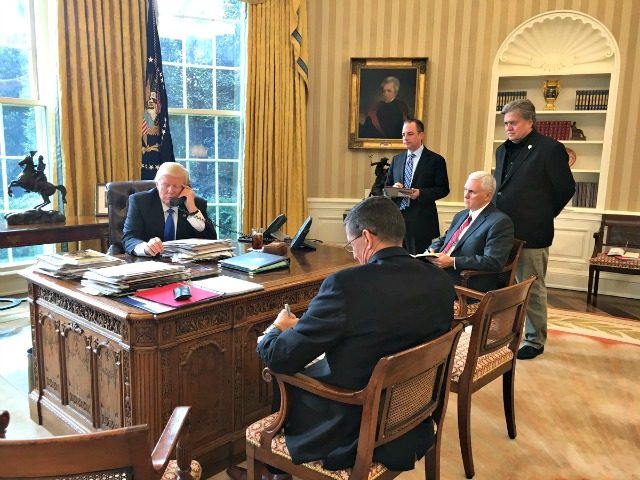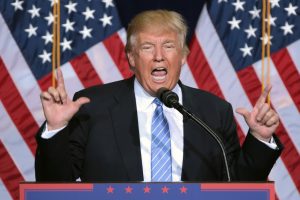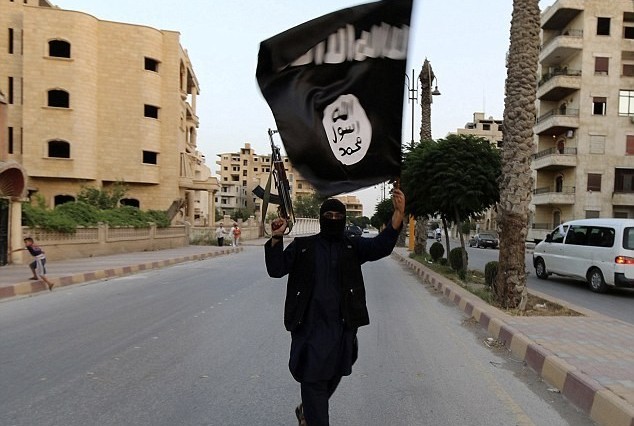by Daniel Luban
The executive order that Donald Trump signed last Friday was a shock but not entirely a surprise. The outlines of the order—which temporarily denied entry to the U.S. to all refugees as well as all citizens of seven Muslim-majority countries—could not have been fully unexpected given Trump’s stated promises in the year-and-a-half since he first announced his presidential campaign. That something like this was predictable does not, of course, make it any less vile. Its genesis in the “Muslim ban” that Trump suggested on the campaign trail was clear, however many flimsy rationalizations to the contrary his administration might offer.
The shock of the order was due less to its content than to its sudden and chaotic promulgation. Refugees who had been assured of their imminent resettlement found themselves stranded or even facing deportation back to their countries of origin. U.S. permanent residents who happened to be abroad were left wondering when, if at all, they might be able to return home. Agents on the ground in charge of enforcing the order often seemed just as at sea as everyone else. The administration eventually caved on its application of the order to green-card holders, even while insisting that it had been “a massive success story in terms of implementation on every single level.” In the meantime, the mushrooming situation at the airports engendered protests whose size and intensity seemed to have caught even their own participants by surprise.
All this chaos has given rise to a widespread narrative about an administration hamstrung by its own sheer incompetence, a narrative that has taken hold both among the administration’s critics and its defenders. Benjamin Wittes, for instance—normally a hawk, but author of one of the most widely read attacks on the order—excoriated it for sheer “malevolence” that was “mitigated chiefly—and perhaps only—by the astonishing incompetence of its drafting and construction.” On the other side, even those offering qualified defenses of the order felt compelled (like National Review’s Daniel McLaughlin) to criticize the “unnecessary chaos” triggered by the administration’s lack of preparation, which constituted a major “unforced error.”
This narrative may be right—I certainly hope it is. An administration too incompetent to act on its own worst impulses is, sadly, perhaps the best we can hope for while Trump remains in office. But as we try to puzzle out what the Trump era has in store, we should make sure to consider every possible interpretation of what we see in front of us. So in thinking through what’s happened over the past weekend, let’s abandon for the moment the assumption of a considered policy—however vicious it might be—undercut by unnecessary chaos. Instead, let’s consider whether there might have been any purpose to the chaos itself.
Doing so does not involve imagining that the administration is omnipotent and invincible. Already, a counter-narrative has sprung up, according to which everything that’s taken place since Friday has been part of a master plan. This narrative could also be right—I hope not!—but my argument here is more limited. I’m inclined to believe (perhaps optimistically) that the administration was genuinely surprised by the intensity of the backlash against the order. My focus here is not on what’s happened over the last few days, but on the initial and supposedly incompetent rollout of the order itself.
Bannon in the Lead
In some sense it’s misleading to talk about “the administration” as a whole: everything so far indicates that we are dealing with a highly factionalized and disconnected operation, in which many cabinet members are seemingly unaware of decisions coming from the White House until they’re announced. This is not to say, however, that the Trump White House is entirely unstructured or chaotic. Reading the tea leaves a week into the term—necessarily a painfully incomplete exercise—suggests that so far power has been highly centralized in the White House, and in particular with aides Steve Bannon and Stephen Miller, who have reportedly been responsible for the executive orders. Bannon and Miller are political operatives, with no expertise in any of the areas for which they’re setting policy. At the same time, they are hardly leaves blown in the wind; every indication is that they have strong preferences and are assertive in pursuing them. One of the most striking stories from this weekend was CNN’s report that the Department of Homeland Security had originally decided to exempt green-card holders from the executive order, only to be overruled by Bannon and Miller.
The failure to exempt green-card holders was seemingly a major miscalculation: one of the first aspects of the order to attract fire from conservatives, and the first that the administration appeared to back down from. Likewise, nothing was more predictable than that issuing the order without any warning and any delay in its execution would lead to precisely the nightmare that we’ve witnessed over the last few days. Yet Bannon and Miller went into these decisions with their eyes open. On the green card issue, they consciously and concertedly overruled DHS and its chief John Kelly, a retired four-star Marine general. House Speaker Paul Ryan, in defending the order, suggested that “no one wanted to see people with green cards or special immigrant visas, like translators, get caught up in all of this.” On the contrary, key decision-makers did, in fact, want to see such people get caught up in all of this.
Could Bannon and Miller really have had no inkling about what the order would trigger? Or, to ask the question from another angle: was there anything that the chaos accomplished? Many analysts have pointed out that the executive order would be useless or actively counterproductive in its stated goal of reducing the threat of terrorism, and have suggested that its real rationale sprang from domestic political considerations. In one sense its target may have been Trump’s base, to whom the order offered a piece of red meat and a tacit fulfillment of one of his uglier campaign promises.
Another explanation, not inconsistent with the previous one, is that the order aimed at political polarization more generally; inciting protests to serve as hate-objects was part of the plan. Both explanations have some plausibility—although the second should not serve as an excuse for Trump’s opponents to preemptively surrender, but simply as a reminder to be prepared for a fight. At the same time, neither one really explains the chaos of the implementation period, which is likely to have dampened enthusiasm among Trump’s base and to have increased the resonance of the protests with the public.
The Real Audience
I suspect that the “unnecessary chaos” had a more specific intended audience—Muslims and immigrants here in America. The message delivered was a simple one: you will never be truly safe here. Even if you have lived in America for decades, have children who are U.S. citizens, own a business or run a community organization, it can all be taken away with the stroke of a pen. Perhaps not right now: if you were unfortunate enough to be out of the country for a vacation or business trip or funeral, the government will let you back in eventually, this time. But it will only do so after keeping you on the hot seat long enough to make clear that next time might be different, and that there is no way of knowing ahead of time.
If we view a central goal of the policy not as preventing terror but as sowing terror, many of the seemingly irrational or incompetent features of its rollout begin to make more sense. The fact that it was indiscriminate, applying to everyone with citizenship from the seven countries regardless of their immigration status or history in the U.S. The fact that it was out-of-nowhere, affecting anyone who happened to be outside the country without any advance warning. The fact that its parameters were murky, suggesting to immigrants that even having made it through past forms of vetting was no guarantee of continued residence. It is certainly important to question the implied dichotomies (between “good” and “bad” Muslims, upstanding citizens and potential terrorists) that underlie many criticisms of Trump’s executive order. But it is equally important to recognize that the order itself also swept away these distinctions, from the opposite direction.
Steve Bannon is, famously, the liaison between White House and white nationalism. He has done little to conceal his conviction that immigration as such is the problem, independent of the social problems or security concerns to which it allegedly gives rise. (Asked to explain Bannon’s thinking in writing the executive order, one confidant reportedly gave a simple answer: “America First. Americans First.”) Trump’s order—its supposedly bungled execution very much included—might reasonably be viewed in light of the broader goal of a white Christian America. The point is not simply to keep out new arrivals, much less the vanishingly rare “terrorists” among them, but to make life unpleasant enough to convince those Muslims and immigrants who are already here to leave.
Formal legal discrimination will probably not be the main mechanism for doing so. Fostering a pervasive sense of fear and uncertainty is equally effective, and far easier to get away with. There is no need to actually round up Muslims. Make it seem like such an event is possible on the horizon, and many of them will (quite reasonably) try to find a less hateful corner of the world to live in. In this regard it is perfectly useful to come off as unhinged, not entirely able to calculate the consequences of one’s own actions. And the strategy is very difficult to fight against. We might manage to defeat this or that policy, but who of us could honestly claim to guarantee that things won’t get any worse? For now, the best we can do is convince the administration that it has made a serious mistake, by exacting a political price that they will hesitate to pay in the future. That’s up to us.






On the Travel Ban of Muslim Countries:
I have lived through 7 presidencies and they all have made mistakes big and small. Most do their best to recover from the fumbles. This executive order has been the biggest f*** up of American public life. The confusion, dislocation, heart ache and its cost to citizens and the country is obvious to everyone regardless of party affiliation and expertise. An amateurish production on a monumental scale, as a failure of coordination and communication it will remain unrivalled for a long time. What has happened is water under the bridge. But even more astonishing is the refusal of the administration to admit its absolute incompetence. This ought to be cause for concern for all Americans, the administration refuses to admit such an obvious disaster means there shall be no corrective action for the similar future executive orders. They are lying in the face of entire citizenry and the press on such basic things that it is not a “BAN”, while the spokesperson for the president and the president himself has called this a ban. White house chief of staff is on record saying “we apologize for nothing”. Fastening of seat belts for the rocky ride ahead won’t be enough, keep your parachutes and personal floatation devices close at hand.
Except for its immediate application and the chaos it caused, this was NOT Trump’s order but Barack Obama’s form December 2015, all waiting, like so many powers to come, for a POTUS like Trump to enact. Check it out; Obama got no flak at all. Trump wants chaos and the shock doctrine in action. Terrorism is not reduced, Muslims are not the only target.
Mr. Trump and his supporters are master of alternate facts and never henceforth seen ability to deny facts when they come across them. I have seen our illustrious leader assert to the press “everything is going nicely” and the white house chief of staff said on record “we have nothing to apologize for” and that is crux of my lament. What would it take to shame the Trump team, an inadvertent nuclear war. They were busy fixing facts until yesterday after the fact. This reference to Obama decision to identify these countries is also wrong, they had only banned unnecessary travel by American citizens and state department officials to these countries. There was no need to have the congressional staffers sign non-disclosure agreements for their cooperation. Whatever white house does, do it in daylight and in cooperation with rest of the establishment. That is not likely to happen, because we have a know it all president.
The hidden agenda behind the actions of this administration are being revealed successively! The intent behind the Banning EO was only and only for Iran and the other 6 countries are being punished for the sake of Iran! These seven countries haven’t produced a single terrorist or a single terrorist act and yet those responsible for 9/11 and other terrorist acts are left off of the list because the US kisses up to the Saudis and Israelis! Now the administration made the announcement today of the false flag against Iran for testing its defensive missiles, of course the defensive missiles have been tested since GWB’s era. Now we have to wait for the US next step against Iran!